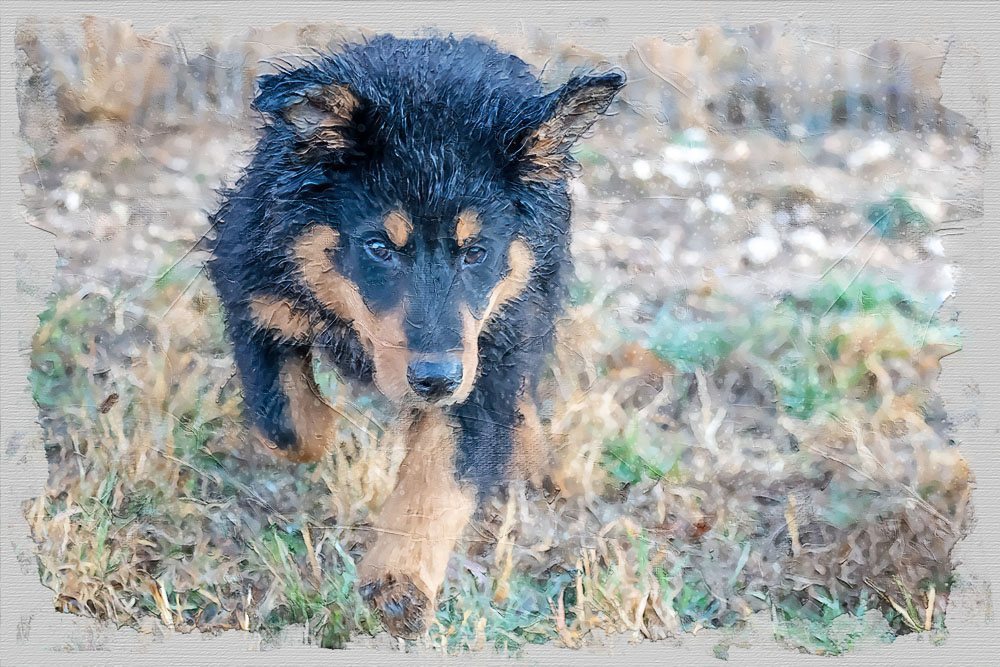There are only a few breeders of the Old-fashioned Black and Tan English Shepherd. These are unique farm dogs with a specific heritage.
So, as you might expect, there is a waiting list for Old-fashioned Black and Tan English Shepherd puppies. If you’re looking for a farm collie-type English Shepherd, which is a different farm dog who can be sable, white or tri-colored, there is no need to get on our waiting list. Over the past few years, farm collie-type English Shepherds have been registered at a rate of several hundred litters per year.[1]https://www.esc-registry.org/ Given that large number, it should be quicker and easier for you to find a farm collie-type English Shepherd breeder. Our Tennessee nonprofit corporation only works with blue-ribbon breeders of the Old-fashioned Black and Tan English Shepherd bloodline. But, how can you tell if a breeder is breeding blue-ribbon Old-fashioned Black and Tan English Shepherds? We use three investigations to determine if a dog is authentic: phenotype, genotype and history. The details of these investigations are outlined below. But there are a few quick shortcuts to make an initial determination. To pass the “eye-test”, both parents of the litter will be black and tan. And every puppy in the litter will be black and tan. If either parent is not a black and tan, or if even one puppy in the litter is not a black and tan, it’s probably a good bet that this isn’t an authentic litter of blue-ribbon Old-fashioned Black and Tan English Shepherds.
As I mentioned before, there are three investigations we can use to ascertain with confidence if a dog is a blue-ribbon Old-fashioned Black and Tan English Shepherd:
The first way you can tell is by appearance and behavior (phenotype). To know what you’re looking for, familiarize yourself with the bloodline standard. This same standard of the Old-fashioned Black and Tan English Shepherd has been around, virtually unchanged, for decades. It was initially written by Tom Stodghill, founder of the English Shepherd Club of America. The bloodline standard was later revised by John and Pauline Blankenship. It is published online here:
The second way to classify an Old-fashioned Black and Tan English Shepherd is historically by pedigree. The preferred Old-fashioned Black and Tan English Shepherd has nothing but black and tan dogs is his or her pedigree. Ideally, the pedigree will go all the way back to black and tan dogs who were registered with the IESR or the ARF. There are exceptions. For example, an ancestor 3 generations back who was black and white, so long as all the ancestors since are demonstrably Old-fashioned Black and Tan English Shepherds. Conversely, if a dog’s sire or dam is not a black and tan, that is a composite dog. Not an Old-fashioned Black and Tan English Shepherd. In fairness, this is not a cut-and-dried investigation. I personally feel that an Old-fashioned Black and Tan’s three generation pedigree should be at least 7/8 black and tan. But some of my respected colleagues feel that the pedigree should be entirely black and tan. If you are in doubt, ask the opinion of an experienced black and tan breeder. I’ll link to a list of qualified breeders below.
Finally, genotype can be used to help with our classification. I’m not an expert on genetics, and this isn’t a post about genetics. So, let’s stay high level for this third investigation. An Old-fashioned Black and Tan English Shepherd will always have two parents who are ‘AtAt’ on the A Locus. And through in-depth research, we know that most of the modern males from the Old-fashioned Black and Tan English Shepherd bloodline are of two possible haplotypes. Those are A1a H1a.48 and A1a H1a.29. The females that we’ve tested are A1a A388, A1d A247 and C2 C42/54/55. This is an evolving list, but we’re unaware of any exceptions at this time. You don’t have to be an expert in genetics to use genotype as an investigation. You just have to pay for a test and read the report. Don’t let it intimidate you.
To summarize, three of the most conclusive investigations we can use to classify Old-fashioned Black and Tan English Shepherds are genotype, phenotype, and history. In isolation, any one of these three investigations can be inconclusive. But when all three are used together, we can assert a classification with a reasonable amount of confidence. This last statement is an important point. The most accurate classifications will use all three investigations.
As a public service, OBTESA investigates and endorses breeders of Old-fashioned Black and Tan English Shepherds. You can find that list in each edition of the OBTESA quarterly newsletters, and it is also published online here:
https://reports.obtesa.com/records/breeders/
The OBTESA Breeder Incubator Programs is an effort to increase our number of blue ribbon breeders. You can read about our progress here:
Finally, you may be wondering if it is a good idea to focus our efforts on the integrity of the black and tan bloodline. The answer is unequivocally yes. But what about genetic diversity? The fact is many breeders and dog people are confused about breed management best practices. This is entirely understandable, because social networks and breed clubs are a large source of misinformation on the subject of breed management. But don’t take my word for it. Investigate for yourself. Fortunately for us, the experts at the Livestock Conservancy have written an excellent book about breed management. Here’s the reference.
Sponenberg, D. Phillip, Jeannette Beranger, and Alison Martin. Managing Breeds for a Secure Future: Strategies for Breeders and Breed Associations. Second edition. Sheffield, UK: 5M Publishing, 2017.
References
| ↑1 | https://www.esc-registry.org/ |
|---|

